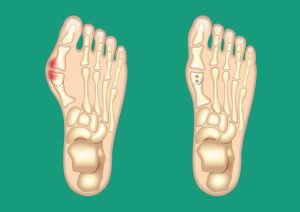
A bunion is an enlargement of the big toe joint of the foot, typically associated with the bending of the big toe over towards the lessor toes (hallux valgus). They are more common in females and more common in the older ages. They can cause significant discomfort and pain, as well as cause problems with shoe fitting.
The cause of bunions is not totally clear. Obviously tight fitting shoes is a problem as they bend the big toe over towards the lessor toes. Adding weight to this argument is that females tend to wear tighter dress shoes and the problem is more common in females. However, people who never wear shoes also can get them, so there is an obvious hereditary component to it. However, those who do wear shoes tend to get more severe bunions and more painful bunions than those who do not wear shoes.
The symptoms from bunions are basically of two types. There are often arthritis type pains from inside the joint and pains from the pressure on the enlarged joint from the shoes. There can also be secondary symptoms, such as hammer toes from the big toe pushing on the second toe.
The primary treatment option is surgery, as there is no conservative measures that can make it go away. There are plenty of alternatives to surgery, but none of them make the lump or enlarged joint go away. Conservative measure include exercise to help the arthritis pain coming from inside the joint; correct fitting footwear that is wide enough in the forefoot; and the use of padding to keep the pressure of the enlarged joint.
There are many different surgical options that range from a simple removal of the lump to a major reconstruction of the bone to correct the alignment. The choice of procedure will depend on the preferences of the surgeon and what structures are involved in the problem, which can vary quite a bit.
{openx:878}